Comprehensive Network Design for CLD Hospital: Addressing Needs
VerifiedAdded on 2023/04/10
|14
|1813
|160
Report
AI Summary
This report provides a comprehensive analysis and network design solution for CLD Hospital, addressing the institution's current and future network requirements. It begins by outlining the limitations of the existing RIPv1 protocol and summarizing the hospital's network needs, including subnet calculations and key assumptions related to internet access and user mobility. The design emphasizes mobility, security using a SOPHOS firewall, and network performance to support 461 devices. Wireless access points are strategically placed throughout the ten floors to ensure seamless connectivity for medical staff, particularly enabling access to patient information stored on floors 5-10 from any location within the hospital. The proposed network utilizes a multi-layered switching architecture with VLANs assigned to each floor for enhanced security and management. The report also includes ping command outputs to demonstrate successful communication between devices on different floors, validating the effectiveness of the design. The recommended solution includes Cisco 2800 series routers and Cisco 350 series Client Adapters. This design aims to improve network performance, enhance data accessibility for medical personnel, and support future growth.

Running head: NETWORK DESIGN FOR CLD HOSPITAL
Network Design for Cld Hospital
Name of the Student
Name of the University
Author Note
Network Design for Cld Hospital
Name of the Student
Name of the University
Author Note
Paraphrase This Document
Need a fresh take? Get an instant paraphrase of this document with our AI Paraphraser
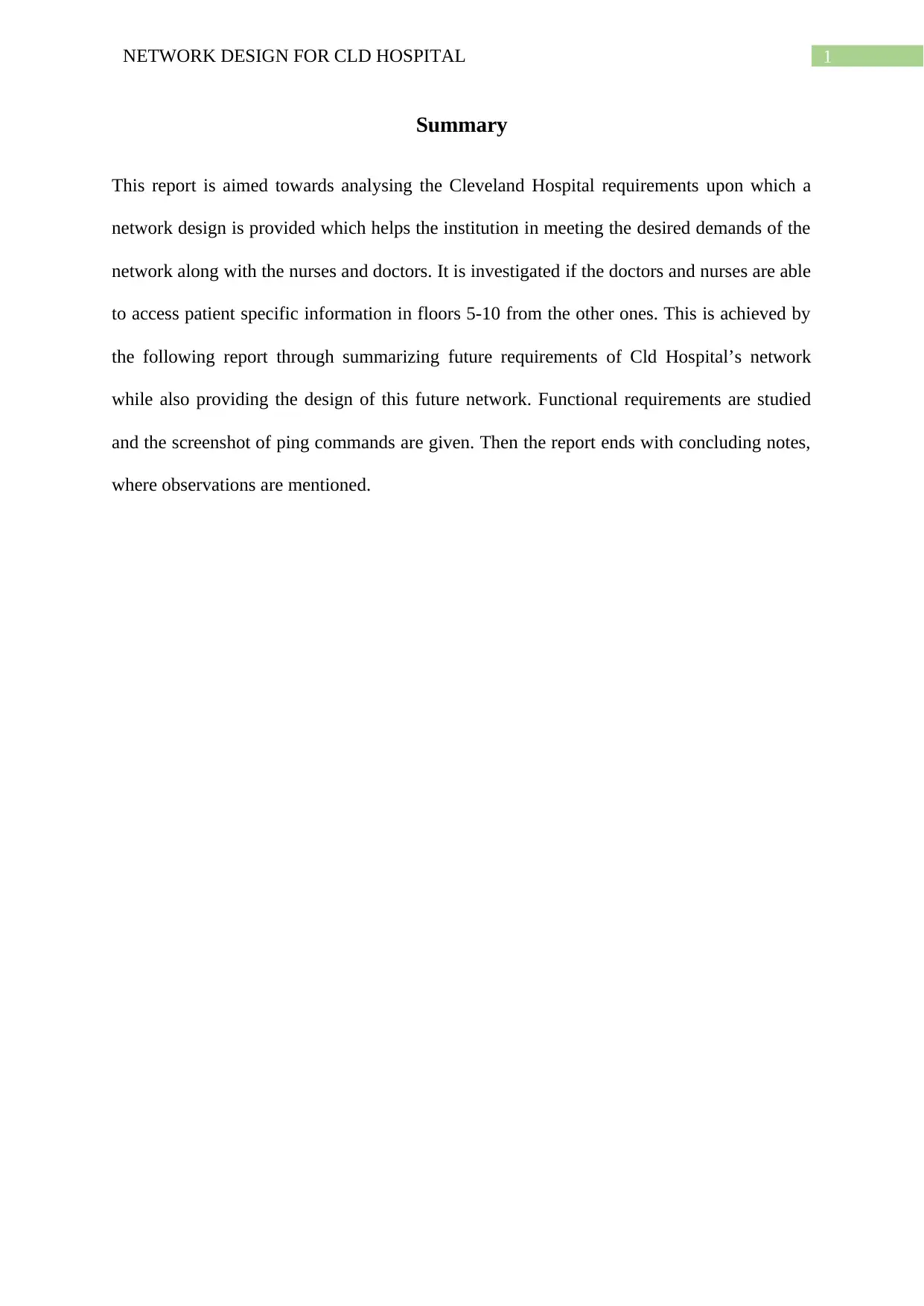
1NETWORK DESIGN FOR CLD HOSPITAL
Summary
This report is aimed towards analysing the Cleveland Hospital requirements upon which a
network design is provided which helps the institution in meeting the desired demands of the
network along with the nurses and doctors. It is investigated if the doctors and nurses are able
to access patient specific information in floors 5-10 from the other ones. This is achieved by
the following report through summarizing future requirements of Cld Hospital’s network
while also providing the design of this future network. Functional requirements are studied
and the screenshot of ping commands are given. Then the report ends with concluding notes,
where observations are mentioned.
Summary
This report is aimed towards analysing the Cleveland Hospital requirements upon which a
network design is provided which helps the institution in meeting the desired demands of the
network along with the nurses and doctors. It is investigated if the doctors and nurses are able
to access patient specific information in floors 5-10 from the other ones. This is achieved by
the following report through summarizing future requirements of Cld Hospital’s network
while also providing the design of this future network. Functional requirements are studied
and the screenshot of ping commands are given. Then the report ends with concluding notes,
where observations are mentioned.

2NETWORK DESIGN FOR CLD HOSPITAL
Table of Contents
Introduction................................................................................................................................3
Discussion..................................................................................................................................3
Limitations of RIP..................................................................................................................3
Requirements Summary.........................................................................................................3
Subnet Calculation.................................................................................................................4
Assumptions.......................................................................................................................6
Mobility Requirements:.....................................................................................................6
Security Requirements:......................................................................................................6
Performance Requirements................................................................................................6
Wireless Networks:............................................................................................................7
Future Design of the network.....................................................................................................7
VLAN.....................................................................................................................................7
Output (Ping reply)................................................................................................................8
Devices Suggested.................................................................................................................9
Cisco 2800 series routers...................................................................................................9
Cisco 350 series Client Adapters.......................................................................................9
Conclusion..................................................................................................................................9
References................................................................................................................................11
References................................................................................................................................12
Table of Contents
Introduction................................................................................................................................3
Discussion..................................................................................................................................3
Limitations of RIP..................................................................................................................3
Requirements Summary.........................................................................................................3
Subnet Calculation.................................................................................................................4
Assumptions.......................................................................................................................6
Mobility Requirements:.....................................................................................................6
Security Requirements:......................................................................................................6
Performance Requirements................................................................................................6
Wireless Networks:............................................................................................................7
Future Design of the network.....................................................................................................7
VLAN.....................................................................................................................................7
Output (Ping reply)................................................................................................................8
Devices Suggested.................................................................................................................9
Cisco 2800 series routers...................................................................................................9
Cisco 350 series Client Adapters.......................................................................................9
Conclusion..................................................................................................................................9
References................................................................................................................................11
References................................................................................................................................12
⊘ This is a preview!⊘
Do you want full access?
Subscribe today to unlock all pages.

Trusted by 1+ million students worldwide

3NETWORK DESIGN FOR CLD HOSPITAL
Paraphrase This Document
Need a fresh take? Get an instant paraphrase of this document with our AI Paraphraser
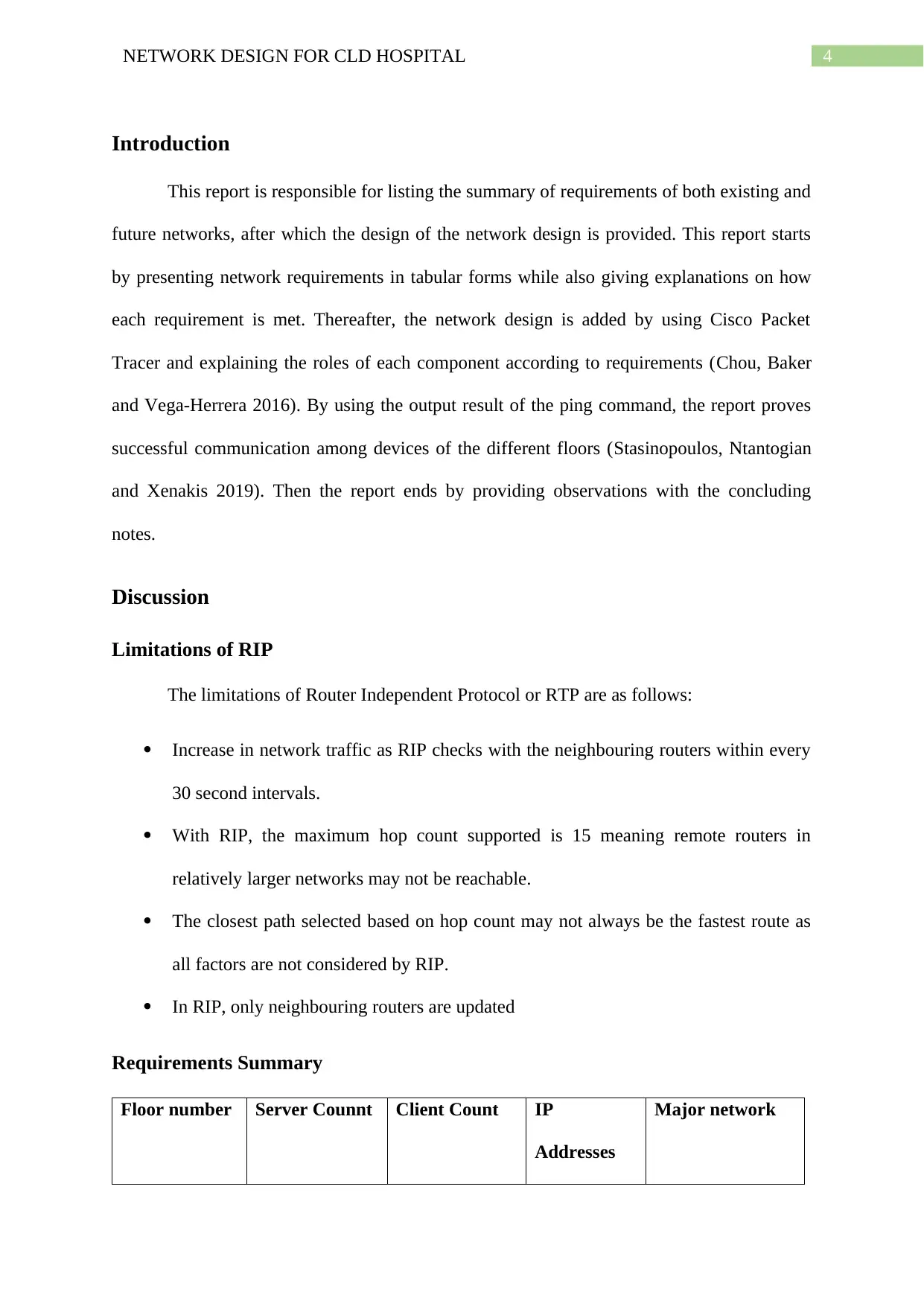
4NETWORK DESIGN FOR CLD HOSPITAL
Introduction
This report is responsible for listing the summary of requirements of both existing and
future networks, after which the design of the network design is provided. This report starts
by presenting network requirements in tabular forms while also giving explanations on how
each requirement is met. Thereafter, the network design is added by using Cisco Packet
Tracer and explaining the roles of each component according to requirements (Chou, Baker
and Vega-Herrera 2016). By using the output result of the ping command, the report proves
successful communication among devices of the different floors (Stasinopoulos, Ntantogian
and Xenakis 2019). Then the report ends by providing observations with the concluding
notes.
Discussion
Limitations of RIP
The limitations of Router Independent Protocol or RTP are as follows:
Increase in network traffic as RIP checks with the neighbouring routers within every
30 second intervals.
With RIP, the maximum hop count supported is 15 meaning remote routers in
relatively larger networks may not be reachable.
The closest path selected based on hop count may not always be the fastest route as
all factors are not considered by RIP.
In RIP, only neighbouring routers are updated
Requirements Summary
Floor number Server Counnt Client Count IP
Addresses
Major network
Introduction
This report is responsible for listing the summary of requirements of both existing and
future networks, after which the design of the network design is provided. This report starts
by presenting network requirements in tabular forms while also giving explanations on how
each requirement is met. Thereafter, the network design is added by using Cisco Packet
Tracer and explaining the roles of each component according to requirements (Chou, Baker
and Vega-Herrera 2016). By using the output result of the ping command, the report proves
successful communication among devices of the different floors (Stasinopoulos, Ntantogian
and Xenakis 2019). Then the report ends by providing observations with the concluding
notes.
Discussion
Limitations of RIP
The limitations of Router Independent Protocol or RTP are as follows:
Increase in network traffic as RIP checks with the neighbouring routers within every
30 second intervals.
With RIP, the maximum hop count supported is 15 meaning remote routers in
relatively larger networks may not be reachable.
The closest path selected based on hop count may not always be the fastest route as
all factors are not considered by RIP.
In RIP, only neighbouring routers are updated
Requirements Summary
Floor number Server Counnt Client Count IP
Addresses
Major network

5NETWORK DESIGN FOR CLD HOSPITAL
1 15 60 75 192.168.100.0/24
2 0 50 50 192.168.101.0/24
3 0 45 45 192.168.102.0/24
4 0 42 42 192.168.103.0/24
5 0 33 33 192.168.104.0/24
6 0 39 39 192.168.105.0/24
7 0 20 20 192.168.106.0/24
8 0 58 58 192.168.107.0/24
9 0 55 55 192.168.108.0/24
10 0 44 44 192.168.109.0/24
Subnet Calculation
Subn
et
Nam
e
Need
ed
Size
Allocat
ed Size Address Mas
k Dec Mask Assignable
Range Broadcast
Floor
1 75 126 192.168.10
0.0 /25 255.255.255.
128
192.168.100.
1 -
192.168.100.
126
192.168.100.
127
Floor
2 50 62 192.168.10
1.0 /26 255.255.255.
192
192.168.101.
1 -
192.168.101.
62
192.168.101.
63
Floor
3 45 62 192.168.10
2.0 /26 255.255.255.
192
192.168.102.
1 -
192.168.102.
62
192.168.102.
63
Floor
4
42 62 192.168.10
3.0
/26 255.255.255.
192
192.168.103.
1 -
192.168.103.
192.168.103.
63
1 15 60 75 192.168.100.0/24
2 0 50 50 192.168.101.0/24
3 0 45 45 192.168.102.0/24
4 0 42 42 192.168.103.0/24
5 0 33 33 192.168.104.0/24
6 0 39 39 192.168.105.0/24
7 0 20 20 192.168.106.0/24
8 0 58 58 192.168.107.0/24
9 0 55 55 192.168.108.0/24
10 0 44 44 192.168.109.0/24
Subnet Calculation
Subn
et
Nam
e
Need
ed
Size
Allocat
ed Size Address Mas
k Dec Mask Assignable
Range Broadcast
Floor
1 75 126 192.168.10
0.0 /25 255.255.255.
128
192.168.100.
1 -
192.168.100.
126
192.168.100.
127
Floor
2 50 62 192.168.10
1.0 /26 255.255.255.
192
192.168.101.
1 -
192.168.101.
62
192.168.101.
63
Floor
3 45 62 192.168.10
2.0 /26 255.255.255.
192
192.168.102.
1 -
192.168.102.
62
192.168.102.
63
Floor
4
42 62 192.168.10
3.0
/26 255.255.255.
192
192.168.103.
1 -
192.168.103.
192.168.103.
63
⊘ This is a preview!⊘
Do you want full access?
Subscribe today to unlock all pages.

Trusted by 1+ million students worldwide
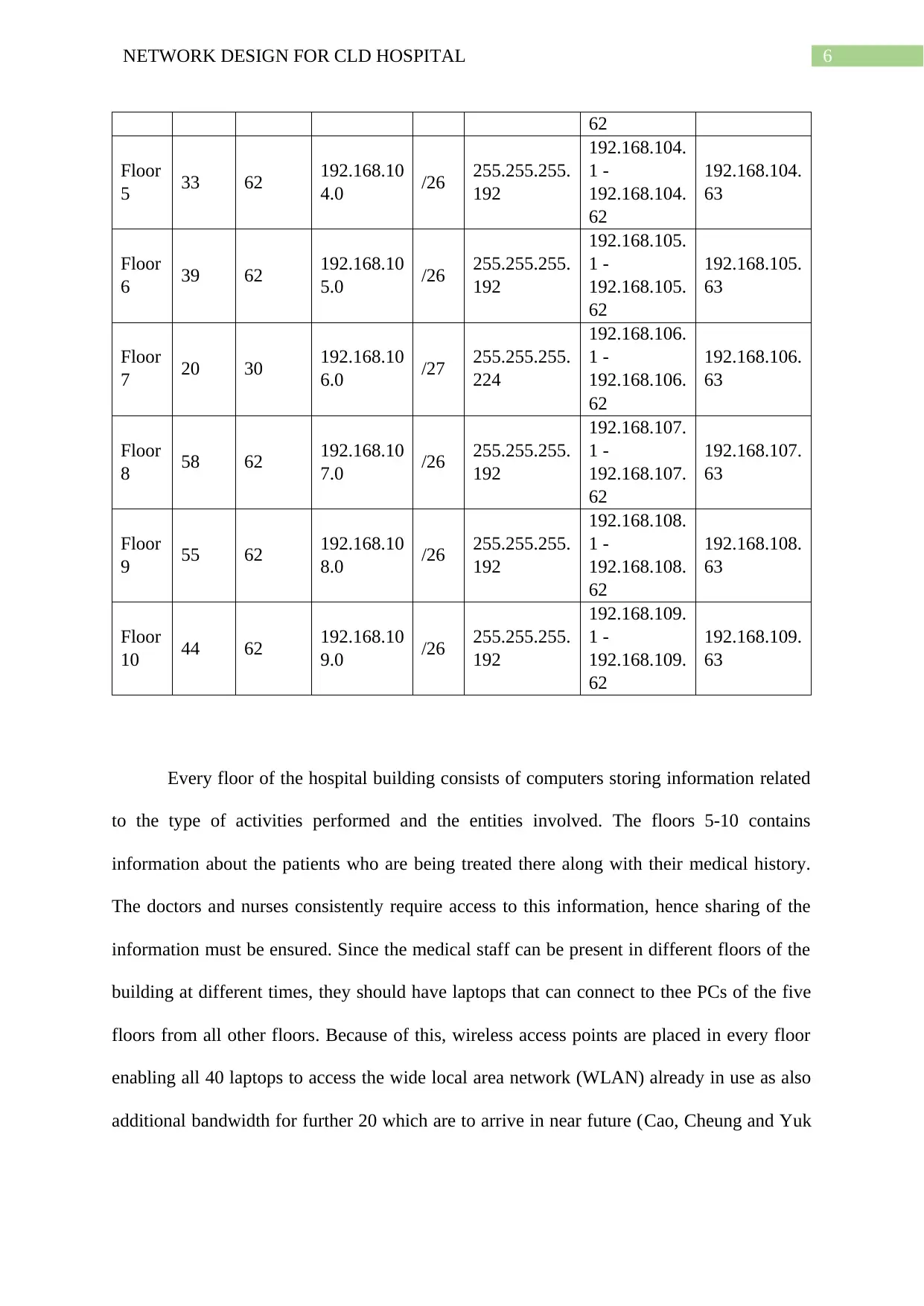
6NETWORK DESIGN FOR CLD HOSPITAL
62
Floor
5 33 62 192.168.10
4.0 /26 255.255.255.
192
192.168.104.
1 -
192.168.104.
62
192.168.104.
63
Floor
6 39 62 192.168.10
5.0 /26 255.255.255.
192
192.168.105.
1 -
192.168.105.
62
192.168.105.
63
Floor
7 20 30 192.168.10
6.0 /27 255.255.255.
224
192.168.106.
1 -
192.168.106.
62
192.168.106.
63
Floor
8 58 62 192.168.10
7.0 /26 255.255.255.
192
192.168.107.
1 -
192.168.107.
62
192.168.107.
63
Floor
9 55 62 192.168.10
8.0 /26 255.255.255.
192
192.168.108.
1 -
192.168.108.
62
192.168.108.
63
Floor
10 44 62 192.168.10
9.0 /26 255.255.255.
192
192.168.109.
1 -
192.168.109.
62
192.168.109.
63
Every floor of the hospital building consists of computers storing information related
to the type of activities performed and the entities involved. The floors 5-10 contains
information about the patients who are being treated there along with their medical history.
The doctors and nurses consistently require access to this information, hence sharing of the
information must be ensured. Since the medical staff can be present in different floors of the
building at different times, they should have laptops that can connect to thee PCs of the five
floors from all other floors. Because of this, wireless access points are placed in every floor
enabling all 40 laptops to access the wide local area network (WLAN) already in use as also
additional bandwidth for further 20 which are to arrive in near future (Cao, Cheung and Yuk
62
Floor
5 33 62 192.168.10
4.0 /26 255.255.255.
192
192.168.104.
1 -
192.168.104.
62
192.168.104.
63
Floor
6 39 62 192.168.10
5.0 /26 255.255.255.
192
192.168.105.
1 -
192.168.105.
62
192.168.105.
63
Floor
7 20 30 192.168.10
6.0 /27 255.255.255.
224
192.168.106.
1 -
192.168.106.
62
192.168.106.
63
Floor
8 58 62 192.168.10
7.0 /26 255.255.255.
192
192.168.107.
1 -
192.168.107.
62
192.168.107.
63
Floor
9 55 62 192.168.10
8.0 /26 255.255.255.
192
192.168.108.
1 -
192.168.108.
62
192.168.108.
63
Floor
10 44 62 192.168.10
9.0 /26 255.255.255.
192
192.168.109.
1 -
192.168.109.
62
192.168.109.
63
Every floor of the hospital building consists of computers storing information related
to the type of activities performed and the entities involved. The floors 5-10 contains
information about the patients who are being treated there along with their medical history.
The doctors and nurses consistently require access to this information, hence sharing of the
information must be ensured. Since the medical staff can be present in different floors of the
building at different times, they should have laptops that can connect to thee PCs of the five
floors from all other floors. Because of this, wireless access points are placed in every floor
enabling all 40 laptops to access the wide local area network (WLAN) already in use as also
additional bandwidth for further 20 which are to arrive in near future (Cao, Cheung and Yuk
Paraphrase This Document
Need a fresh take? Get an instant paraphrase of this document with our AI Paraphraser
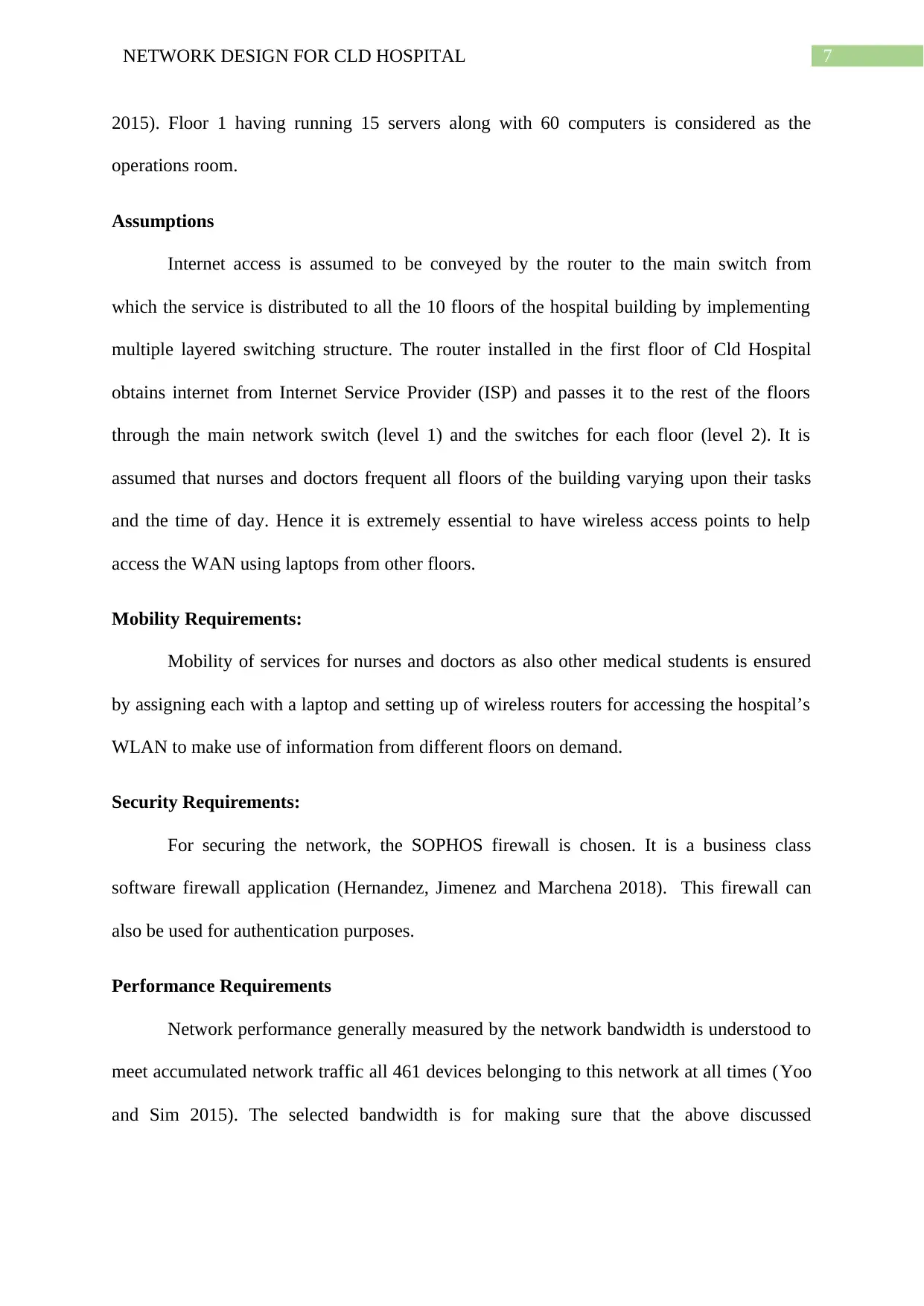
7NETWORK DESIGN FOR CLD HOSPITAL
2015). Floor 1 having running 15 servers along with 60 computers is considered as the
operations room.
Assumptions
Internet access is assumed to be conveyed by the router to the main switch from
which the service is distributed to all the 10 floors of the hospital building by implementing
multiple layered switching structure. The router installed in the first floor of Cld Hospital
obtains internet from Internet Service Provider (ISP) and passes it to the rest of the floors
through the main network switch (level 1) and the switches for each floor (level 2). It is
assumed that nurses and doctors frequent all floors of the building varying upon their tasks
and the time of day. Hence it is extremely essential to have wireless access points to help
access the WAN using laptops from other floors.
Mobility Requirements:
Mobility of services for nurses and doctors as also other medical students is ensured
by assigning each with a laptop and setting up of wireless routers for accessing the hospital’s
WLAN to make use of information from different floors on demand.
Security Requirements:
For securing the network, the SOPHOS firewall is chosen. It is a business class
software firewall application (Hernandez, Jimenez and Marchena 2018). This firewall can
also be used for authentication purposes.
Performance Requirements
Network performance generally measured by the network bandwidth is understood to
meet accumulated network traffic all 461 devices belonging to this network at all times (Yoo
and Sim 2015). The selected bandwidth is for making sure that the above discussed
2015). Floor 1 having running 15 servers along with 60 computers is considered as the
operations room.
Assumptions
Internet access is assumed to be conveyed by the router to the main switch from
which the service is distributed to all the 10 floors of the hospital building by implementing
multiple layered switching structure. The router installed in the first floor of Cld Hospital
obtains internet from Internet Service Provider (ISP) and passes it to the rest of the floors
through the main network switch (level 1) and the switches for each floor (level 2). It is
assumed that nurses and doctors frequent all floors of the building varying upon their tasks
and the time of day. Hence it is extremely essential to have wireless access points to help
access the WAN using laptops from other floors.
Mobility Requirements:
Mobility of services for nurses and doctors as also other medical students is ensured
by assigning each with a laptop and setting up of wireless routers for accessing the hospital’s
WLAN to make use of information from different floors on demand.
Security Requirements:
For securing the network, the SOPHOS firewall is chosen. It is a business class
software firewall application (Hernandez, Jimenez and Marchena 2018). This firewall can
also be used for authentication purposes.
Performance Requirements
Network performance generally measured by the network bandwidth is understood to
meet accumulated network traffic all 461 devices belonging to this network at all times (Yoo
and Sim 2015). The selected bandwidth is for making sure that the above discussed
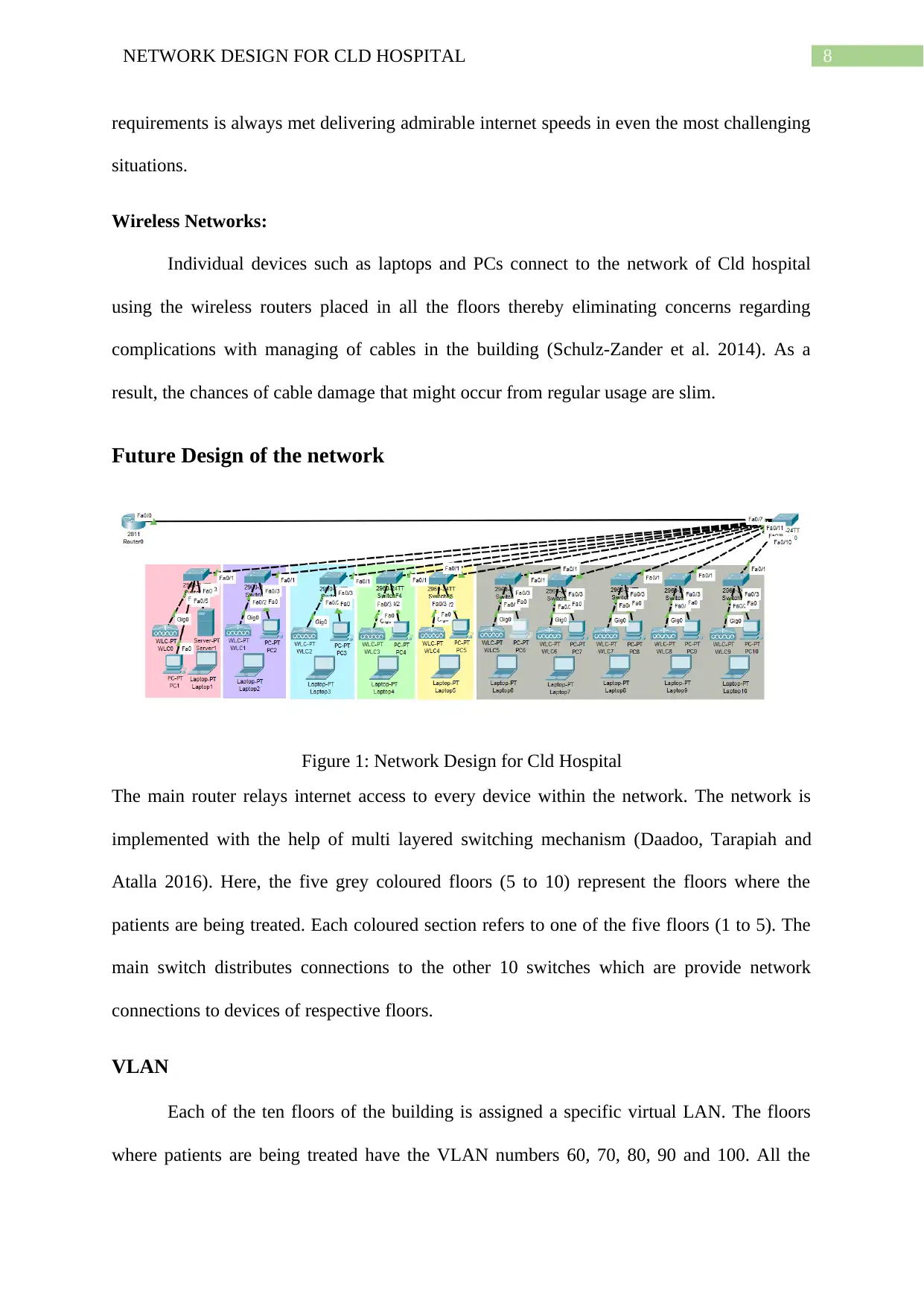
8NETWORK DESIGN FOR CLD HOSPITAL
requirements is always met delivering admirable internet speeds in even the most challenging
situations.
Wireless Networks:
Individual devices such as laptops and PCs connect to the network of Cld hospital
using the wireless routers placed in all the floors thereby eliminating concerns regarding
complications with managing of cables in the building (Schulz-Zander et al. 2014). As a
result, the chances of cable damage that might occur from regular usage are slim.
Future Design of the network
Figure 1: Network Design for Cld Hospital
The main router relays internet access to every device within the network. The network is
implemented with the help of multi layered switching mechanism (Daadoo, Tarapiah and
Atalla 2016). Here, the five grey coloured floors (5 to 10) represent the floors where the
patients are being treated. Each coloured section refers to one of the five floors (1 to 5). The
main switch distributes connections to the other 10 switches which are provide network
connections to devices of respective floors.
VLAN
Each of the ten floors of the building is assigned a specific virtual LAN. The floors
where patients are being treated have the VLAN numbers 60, 70, 80, 90 and 100. All the
requirements is always met delivering admirable internet speeds in even the most challenging
situations.
Wireless Networks:
Individual devices such as laptops and PCs connect to the network of Cld hospital
using the wireless routers placed in all the floors thereby eliminating concerns regarding
complications with managing of cables in the building (Schulz-Zander et al. 2014). As a
result, the chances of cable damage that might occur from regular usage are slim.
Future Design of the network
Figure 1: Network Design for Cld Hospital
The main router relays internet access to every device within the network. The network is
implemented with the help of multi layered switching mechanism (Daadoo, Tarapiah and
Atalla 2016). Here, the five grey coloured floors (5 to 10) represent the floors where the
patients are being treated. Each coloured section refers to one of the five floors (1 to 5). The
main switch distributes connections to the other 10 switches which are provide network
connections to devices of respective floors.
VLAN
Each of the ten floors of the building is assigned a specific virtual LAN. The floors
where patients are being treated have the VLAN numbers 60, 70, 80, 90 and 100. All the
⊘ This is a preview!⊘
Do you want full access?
Subscribe today to unlock all pages.

Trusted by 1+ million students worldwide
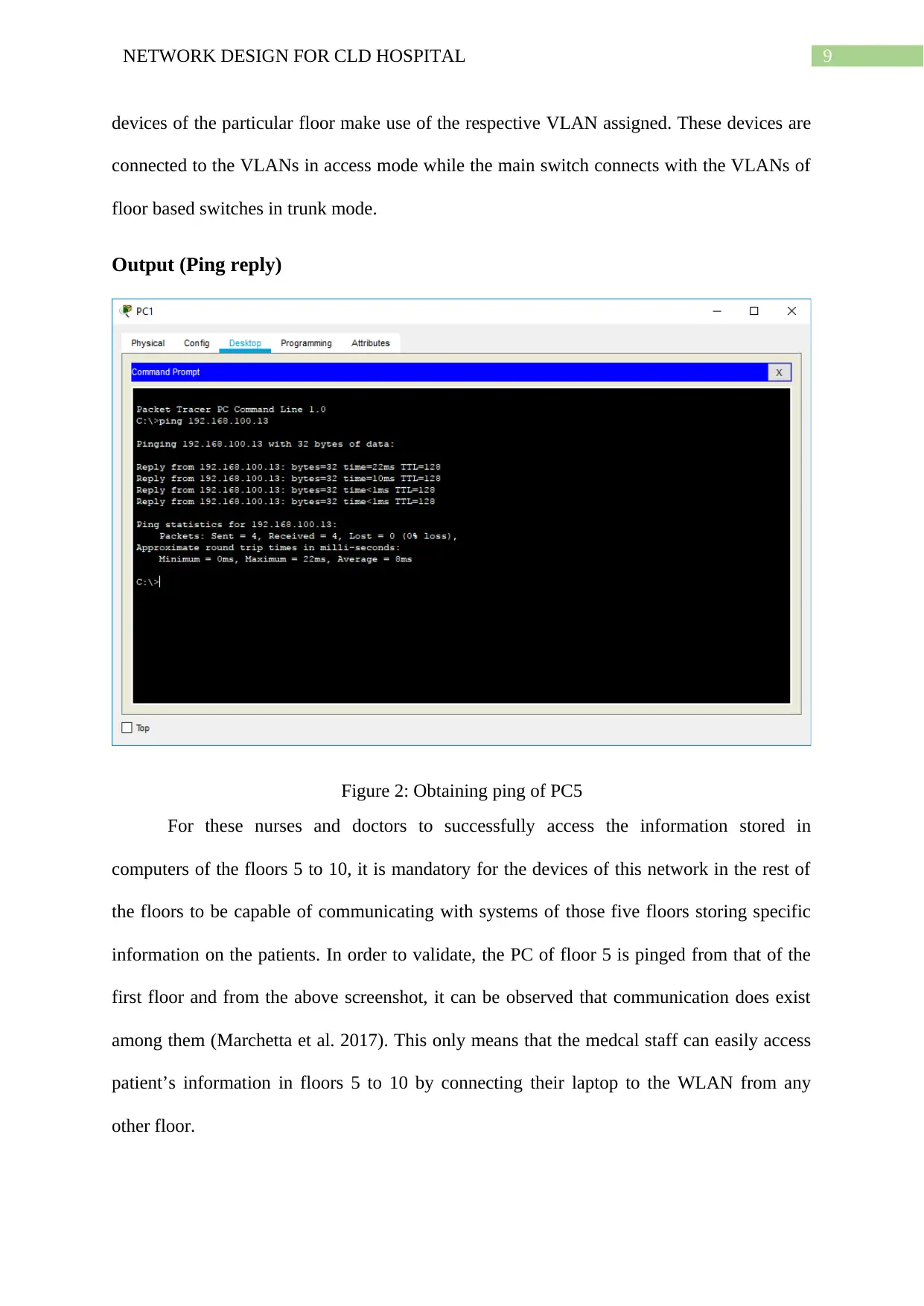
9NETWORK DESIGN FOR CLD HOSPITAL
devices of the particular floor make use of the respective VLAN assigned. These devices are
connected to the VLANs in access mode while the main switch connects with the VLANs of
floor based switches in trunk mode.
Output (Ping reply)
Figure 2: Obtaining ping of PC5
For these nurses and doctors to successfully access the information stored in
computers of the floors 5 to 10, it is mandatory for the devices of this network in the rest of
the floors to be capable of communicating with systems of those five floors storing specific
information on the patients. In order to validate, the PC of floor 5 is pinged from that of the
first floor and from the above screenshot, it can be observed that communication does exist
among them (Marchetta et al. 2017). This only means that the medcal staff can easily access
patient’s information in floors 5 to 10 by connecting their laptop to the WLAN from any
other floor.
devices of the particular floor make use of the respective VLAN assigned. These devices are
connected to the VLANs in access mode while the main switch connects with the VLANs of
floor based switches in trunk mode.
Output (Ping reply)
Figure 2: Obtaining ping of PC5
For these nurses and doctors to successfully access the information stored in
computers of the floors 5 to 10, it is mandatory for the devices of this network in the rest of
the floors to be capable of communicating with systems of those five floors storing specific
information on the patients. In order to validate, the PC of floor 5 is pinged from that of the
first floor and from the above screenshot, it can be observed that communication does exist
among them (Marchetta et al. 2017). This only means that the medcal staff can easily access
patient’s information in floors 5 to 10 by connecting their laptop to the WLAN from any
other floor.
Paraphrase This Document
Need a fresh take? Get an instant paraphrase of this document with our AI Paraphraser
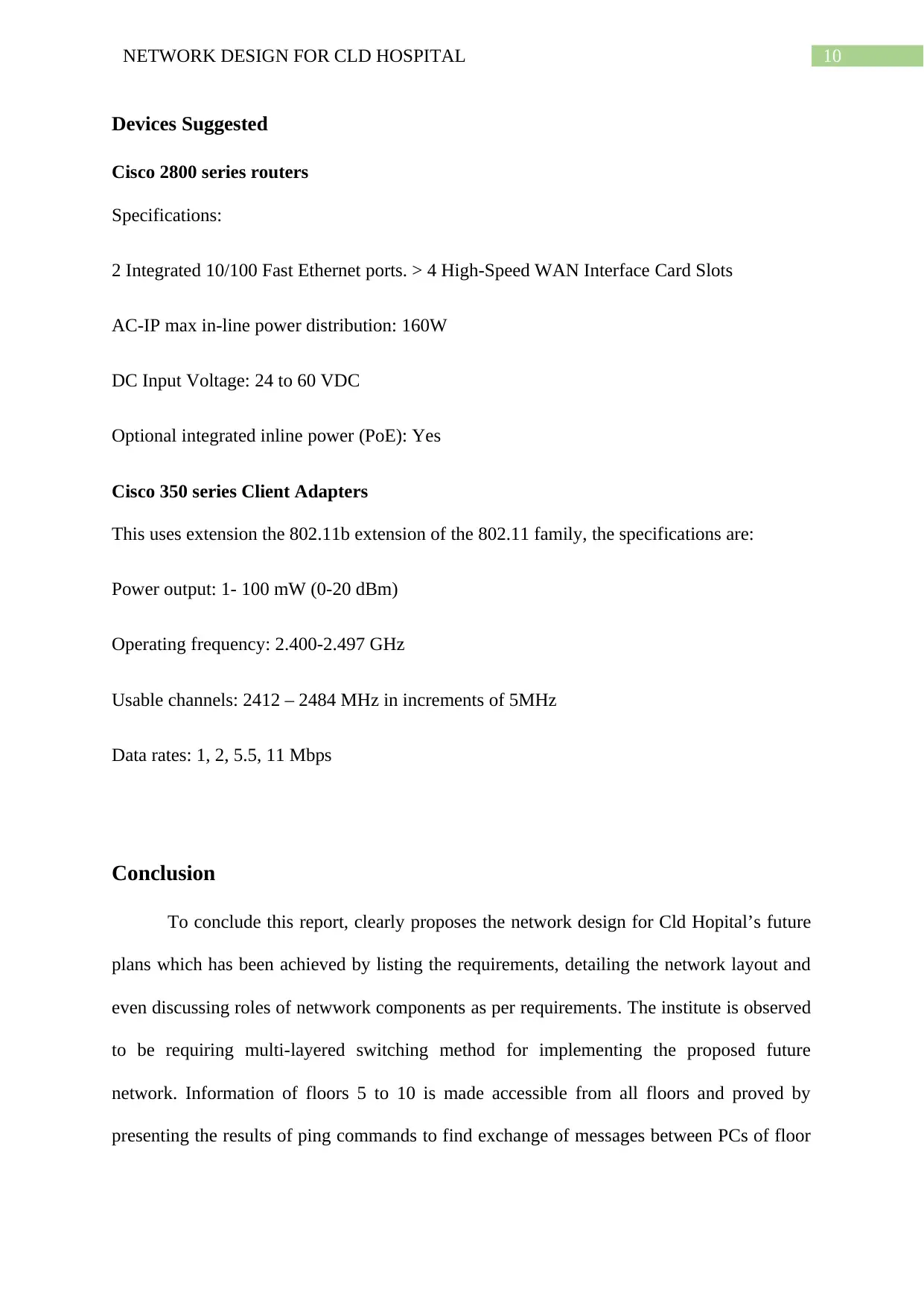
10NETWORK DESIGN FOR CLD HOSPITAL
Devices Suggested
Cisco 2800 series routers
Specifications:
2 Integrated 10/100 Fast Ethernet ports. > 4 High-Speed WAN Interface Card Slots
AC-IP max in-line power distribution: 160W
DC Input Voltage: 24 to 60 VDC
Optional integrated inline power (PoE): Yes
Cisco 350 series Client Adapters
This uses extension the 802.11b extension of the 802.11 family, the specifications are:
Power output: 1- 100 mW (0-20 dBm)
Operating frequency: 2.400-2.497 GHz
Usable channels: 2412 – 2484 MHz in increments of 5MHz
Data rates: 1, 2, 5.5, 11 Mbps
Conclusion
To conclude this report, clearly proposes the network design for Cld Hopital’s future
plans which has been achieved by listing the requirements, detailing the network layout and
even discussing roles of netwwork components as per requirements. The institute is observed
to be requiring multi-layered switching method for implementing the proposed future
network. Information of floors 5 to 10 is made accessible from all floors and proved by
presenting the results of ping commands to find exchange of messages between PCs of floor
Devices Suggested
Cisco 2800 series routers
Specifications:
2 Integrated 10/100 Fast Ethernet ports. > 4 High-Speed WAN Interface Card Slots
AC-IP max in-line power distribution: 160W
DC Input Voltage: 24 to 60 VDC
Optional integrated inline power (PoE): Yes
Cisco 350 series Client Adapters
This uses extension the 802.11b extension of the 802.11 family, the specifications are:
Power output: 1- 100 mW (0-20 dBm)
Operating frequency: 2.400-2.497 GHz
Usable channels: 2412 – 2484 MHz in increments of 5MHz
Data rates: 1, 2, 5.5, 11 Mbps
Conclusion
To conclude this report, clearly proposes the network design for Cld Hopital’s future
plans which has been achieved by listing the requirements, detailing the network layout and
even discussing roles of netwwork components as per requirements. The institute is observed
to be requiring multi-layered switching method for implementing the proposed future
network. Information of floors 5 to 10 is made accessible from all floors and proved by
presenting the results of ping commands to find exchange of messages between PCs of floor

11NETWORK DESIGN FOR CLD HOSPITAL
5 and PCs of floor 1. This suggests doctors cannot have problems in accessing the data of
patients from the assigned laptops when they use newly set up WLAN.
5 and PCs of floor 1. This suggests doctors cannot have problems in accessing the data of
patients from the assigned laptops when they use newly set up WLAN.
⊘ This is a preview!⊘
Do you want full access?
Subscribe today to unlock all pages.

Trusted by 1+ million students worldwide
1 out of 14
Your All-in-One AI-Powered Toolkit for Academic Success.
+13062052269
info@desklib.com
Available 24*7 on WhatsApp / Email
![[object Object]](/_next/static/media/star-bottom.7253800d.svg)
Unlock your academic potential
Copyright © 2020–2025 A2Z Services. All Rights Reserved. Developed and managed by ZUCOL.

